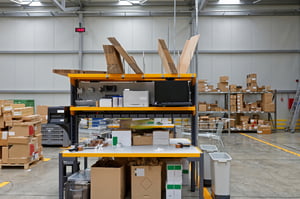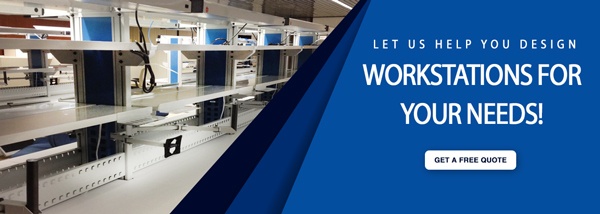As the backbone of any successful e-commerce operation, a warehouse shipping station can make or break your business. Yet many businesses still struggle to optimize this critical area and often overlook the potential for boosting efficiency and productivity.
That can be a costly mistake. A well-designed and organized shipping station can help ensure that orders are fulfilled accurately and quickly, which can lead to increased customer satisfaction, improved operations and ultimately more sales.
Think of it like a set of dominoes. A shipping station that falls behind or struggles to keep up with the pace of orders can have a domino effect on other areas of your operation and can lead to a backlog of unfilled orders, delayed shipments and disgruntled customers.
It’s crucial to ensure that your shipping stations are meeting their fullest potential, and how these stations are designed plays a major role in whether this part of your operations is efficient or causing a drain in your profits.
Essential Tools And Equipment
Setting up a well-equipped shipping station is the first step in ensuring accurate and fast fulfillment of orders. However, the specific tools and equipment that your staff will require will depend on several factors, including the size and complexity of your operation.
orders. However, the specific tools and equipment that your staff will require will depend on several factors, including the size and complexity of your operation.
Here are some of the most common essential items found at warehouse shipping stations:
- Shipping labels and a printer that can produce shipping labels with barcodes, tracking numbers and other important information
- Packaging supplies like boxes, packing materials (bubble wrap, packing peanuts), tape and scissors
- Shipping scales for weighing the packages
- Shipping software to help streamline the shipping process by automating tasks like label printing, carrier selection and tracking updates
- Barcode scanner to help speed up the order processing and reduce errors
- Packing slips and invoices for including in the packages
Storage And Organization Of Shipping Station Tools
The storage and organization of the tools at a shipping station is just as important as the tools themselves. If an employee cannot quickly find a necessary tool, the efficiency of the workspace will suffer.
When purchasing shipping stations for your warehouse, it’s important to work with a high quality industrial furniture company that will customize storage and organization solutions based on the tools your staff uses.
Any type of industrial workbench, including shipping stations, should feature a design that maximizes productivity, not hampers it. For example, some space-saving and organization tools that you can include with your shipping station are:
- Utility drawers that can come in a variety of sizes depending on the tools that are present at a shipping station
- Shelving that can be installed above or below the main work surface
- Upper storage cabinets with flipper doors that provide additional options for tools
- Articulating monitor arms for computer screens
- Keyboard trays that can be added to an articulating arm
- CPU holders that can be fixed or adjustable
- Pegboards that can be added between the uprights and can hold smaller tools or items like a barcode scanner
- Bin rails or panels that store additional parts and accessories
As you’re working with your manufacturer to place each of these items, make sure you take into consideration what makes the most sense for your employees’ natural movements for the tasks they must complete.
Ergonomics At A Shipping Station
If you aren’t considering ergonomics in the design of your warehouse shipping station, you’re not maximizing its potential.
maximizing its potential.
Ergonomics is the scientific study into how people interact with their work environments. The goal of ergonomics is to identify solutions that optimize these environments to boost productivity, comfort and most importantly, safety.
To create a more ergonomically-friendly shipping station, it’s important to consider factors like:
- The height of your shipping station and whether it can be adjusted based on the worker using it at the time
- The range of motion and how the placement of items like a computer monitor and a mouse can impact the way a body moves
- The placement of equipment like scanners and scales, which should ideally minimize the need for excessive reaching, twisting or bending
- Which industrial furniture chairs you pair with the shipping station and whether they offer adjustable heights, sturdy frames, and comfortable backrests and seats
- Adequate lighting to reduce eye strain
- Climate control to keep temperatures and humidity at a comfortable level
By incorporating these ergonomic considerations into the design of your shipping station, you can create a safer, more productive work environment while minimizing worker injuries.
Other Important Shipping Station Considerations
To maximize the potential of your warehouse shipping station, your design should take into account other elements as well, from how much weight your station can support to the materials used to construct it.
Weight Load Capacity
If your warehouse regularly ships heavy items, you’ll need a station that can support that weight. The last thing you need is for your shipping station to sustain damage from products that are too heavy for your bench to support, and then be forced to take that shipping station out of service until it is repaired.
A standard bench will have a weight load capacity up to 750 to 1,000 pounds, but if you ship larger or heavier products, a heavy duty bench can support up to 4,000 to 5,000 pounds, while an extra heavy duty workbench can support up to 10,000 to 20,000 pounds.
Shipping Station Countertop
Shipping stations often sustain significant wear and tear. After all, there are a lot of moving parts and it’s important to have a countertop that can weather the constant use, spills and scratches that can occur in a busy warehouse environment.
There are several types of counters to choose from for your shipping station top. Which material you choose depends on the type of products you typically ship. Here are some common materials used in warehouse environments:
- High Pressure Laminate: HPL laminate tops are used for basic, non-extreme applications. They are not only functional and durable, but also affordable.
- ESD Laminate: This type of work surface is ideal for shipping stations where parts and materials are sensitive to static and need protection.
- Phenolic Resin: These tops are typically used in labs, and are designed as one solid, lightweight countertop that is durable and long-lasting. However, they offer many protections against tough conditions.
- Epoxy Resin: Durable and non-porous, this work surface holds up very well under harsh and extreme conditions such as high heat, but it’s also resistant to water, scuffs and abrasions.
- Stainless Steel: A stainless steel top is resistant to bacteria, rust and corrosion. It also is stain- and heat-resistant.
- Butcher Block: Traditionally used in woodworking and basic assembly applications, this type of countertop is sturdy, but is porous and can dent easily.
Casters For Movement
If you need to move your shipping station around your warehouse or facility, casters are an essential addition to your workspace.
Casters are wheels that can be attached to the bottom of the shipping station, allowing it to be easily moved from one location to another. They come in a variety of sizes and materials, so it’s important to choose the right caster based on the weight of the shipping station and the type of flooring in your facility.
You should also consider whether you need a locking mechanism on the casters to ensure that the shipping station remains stable and secure during use. Locking casters can be engaged to prevent the shipping station from moving, providing a stable and safe work surface.
A Shipping Station Manufacturer For Your Needs
Shipping stations should be personalized to meet the specific needs of your business, taking into account factors such as the volume and type of products you ship, the size and layout of your facility, and the unique requirements of your workforce.
A quality shipping station manufacturer should be experienced in providing solutions for your industry and should thrive at communicating with their clients to offer reliable lead times and delivery options to minimize any disruptions to your operations.


